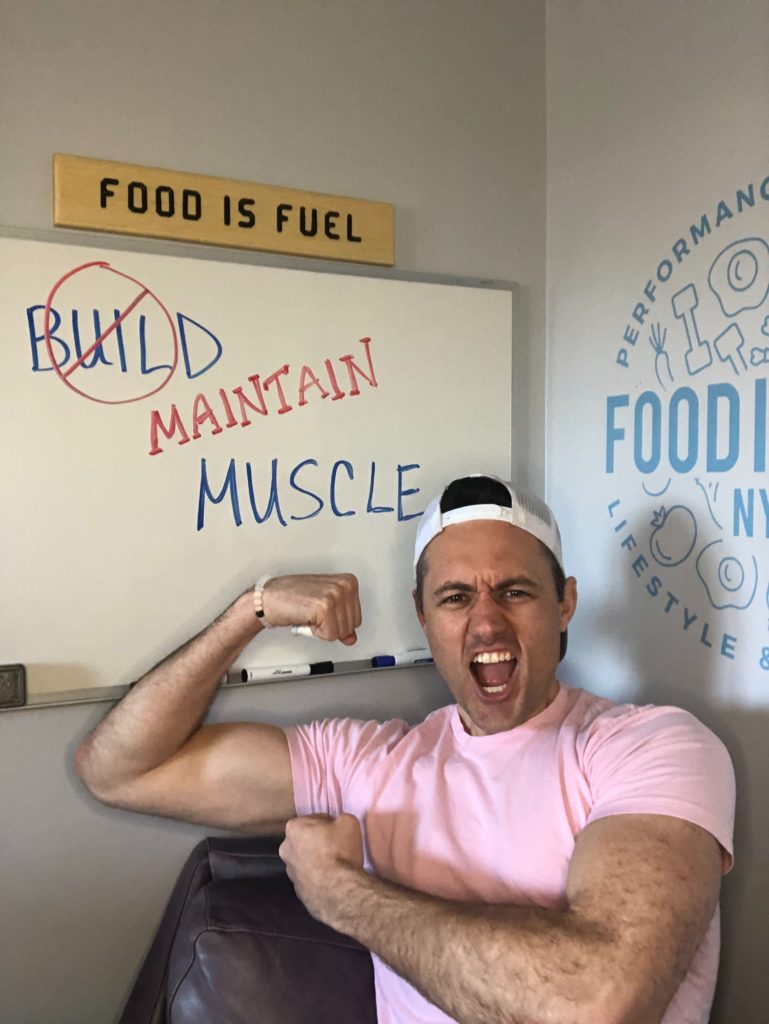By: Registered Sports Dietitian Ryan Turner, RD, CSSD, CDN
Well, really that all depends…
I’m writing this at a time of high stress for many as their workout and eating routines have been completely upended by an extended quarantine of COVID-19. It really depends on how active you’ve been able to remain and how much your food choices have been affected. For many, they’ve become more active and developed more control over their schedule and food choices. For others, they don’t have access to the weights they were once lifting and their eating routine, once driven by fast casual restaurants and food provided from work, has changed drastically.

Either way, many people have reached out, not with worry of uncontrolled eating or weight gain – but rather with questions about how not to lose muscle mass from a nutrition standpoint. I’ll preface this whole post with saying that it’s important to maintain as much resistance training as possible through a down period. You don’t need to hit the personal records you were previously to see muscle maintenance – so just keep moving even if it’s bodyweight focused. Now with that said, lets continue from the standpoint of someone who can’t workout as much as before.
It is true that disuse of your skeletal muscle can lead to atrophy. In many cases this is due to injury or illness. There is less understanding about short term disuse then there is about longer term, greater than 10 days. It’s recognized that this is brought on by lower rates of protein absorption after meals whether that’s because of lower protein intake overall or that protein absorption isn’t as efficient as it would be after usual resistance training (Wall, 2013).
I’m going to take this to a bit of the extreme to make a point by quoting Wall and Loon, “The substantial loss of skeletal muscle mass during disuse is accompanied by a decline in strength that ranges between 0.3% and 4.2% per day. When put into perspective, a person who is normally capable of lifting 50 kg with a single leg extension would hardly be able to lift 40 kg after only 2 weeks of limb immobilization or bed rest.”
Now, the work I just quoted is referring more to elderly patients that have been assigned bed rest. In that population appetite and overall caloric intake is compromised and energy balance (calorie intake) isn’t sufficient. However, it can’t go without saying that if you aren’t aware of how much you require to maintain energy balance at any age, you will compromise muscle. Negative energy balance will result in weight loss and possible muscle loss.
With all of that said here are more defined steps you can take to support you muscle maintenance goals:
The first line of defense in maintaining muscle mass is making sure to not underfeed your body.
You can use this calculator from the Mayo Clinic to best understand the amount of energy your body requires for maintenance. If you’re used to eating based on hunger, that’s excellent, however, it can still be beneficial to understand your current intake vs what your body requires. Some people have primed themselves to “forever diet” and eat under their energy needs from a lack of awareness.
Second line of defense to attenuate muscle loss is to maintain protein intake during period of disuse (10 days or more).
Focusing on food sources containing essential amino acids (histidine, isoleucine, leucine, lysine, methionine, phenylalanine, threonine, tryptophan, and valine) is of utmost importance. This can be simply achieved through whole foods like meat, eggs, tofu, soy, buckwheat, quinoa, and dairy. If appetite and food availability is compromised solutions will need to be discussed and may include supplementation via protein powders. It will be important to understand how much protein you need and how much protein your current food choices provide. See my previous post regarding protein intake to get a better sense of this. In short, I would advise my athletes to continue consuming 0.8-1.1 grams of protein per pound. I’m an advocate of food tracking and measuring to build awareness about what is enough.
Third line of defense may be supplementation.
Recent work also indicates that several nutritional compounds, such as creatine or omega-3 fish oils, may be of additional interest to attenuate the loss of muscle tissue during a period of disuse. Prolonged creatine supplementation has been shown to increase lean body mass even in the absence of structured resistance training (van Loon, 2003). General recommendations for creatine use is between 3-5 grams daily. Fish oil also found to be a potential benefit in subjects when they were supplemented with 4 g of omega-3 fish oils per day for 8 weeks. This resulted in an increase in the muscle protein synthesis when essential amino acids were present (Smith, et al., 2011). Some focus had been placed on vitamin D, however in healthy adults with adequate vitamin D intake, it wasn’t found to be all too beneficial in regards to muscle maintenance during disuse.
Bottom Line: Understand how much your body needs to maintain itself through calories and protein. As always prioritize what’s needed through food first. If possible, discuss with your Registered Dietitian about including beneficial supplements like creatine and EPA/DHA from fish oil.
Benjamin T.Wall, Marlou L.Dirks, Luc J.C.van Loon. Skeletal muscle atrophy during short-term disuse: Implications for age-related sarcopenia. Ageing Research Reviews
- Volume 12, Issue 4, September 2013, Pages 898-906
- Benjamin T Wall,Luc JC van Loon. Nutritional strategies to attenuate muscle disuse atrophy. Nutrition Reviews, Volume 71, Issue 4, 1 April 2013, Pages 195–208.
- van Loon L Oosterlaar A Hartgens F, et al. Effects of creatine loading and prolonged creatine supplementation on body composition, fuel selection, sprint and endurance performance in humans. Clin Sci (Lond). 2003;104:153–162.
- Smith G Atherton P Reeds D, et al.Omega-3 polyunsaturated fatty acids augment the muscle protein anabolic response to hyperinsulinaemia-hyperaminoacidaemia in healthy young and middle-aged men and women.Clin Sci (Lond).2011;121:267–278.
